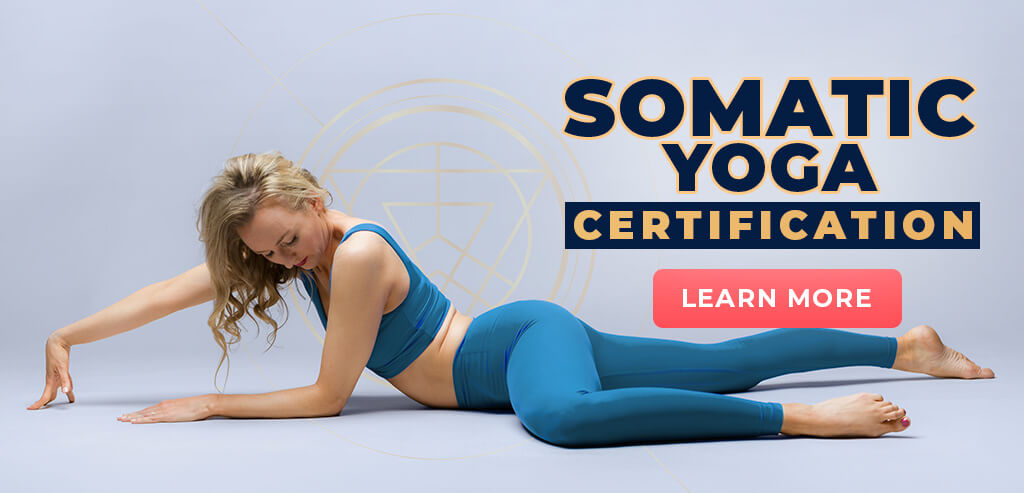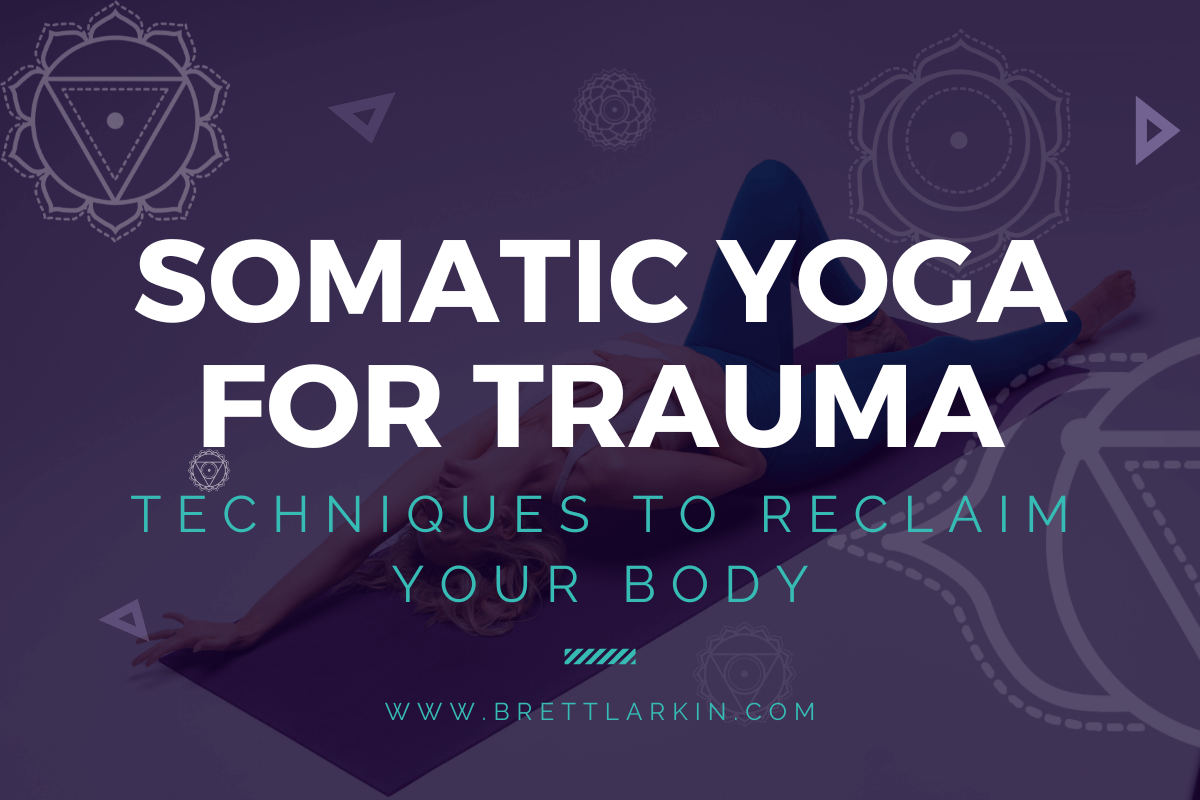Life can throw some curveballs, leaving us with wounds that aren’t always visible on the surface.
Peter Levine, a renowned psychologist and expert in the field of trauma healing, defines trauma as “an injury caused by an overwhelming event that is beyond a person’s capacity to cope.”
Somatic yoga for trauma widens your capacity to cope.
Because here’s the thing: healing is possible, and so is trauma recovery. Somatic yoga, as an arm of somatic therapy, is here to lend a helping hand.
Sometimes I like to call it trauma sensitive yoga. You can use somatic exercises to release tension and process a traumatic event in a safe, nurturing way.
In fact, many people with post traumatic stress disorder have found healing trauma through soothing the nervous system to be the most effective.
Whether you’re dealing with past experiences or navigating present challenges, this gentle yet powerful practice offers a safe space to explore, heal, and reconnect with your body and spirit.
Somatic experiencing is all about nurturing your mind body connection and deepening your body awareness, so you can feel your physical sensations and heal any trauma response.
As a yoga teacher, I recommend somatic yoga for trauma to anyone who is currently in therapy for trauma, or is dealing with trapped emotions and looking for ways to reduce stress.
So let’s embark on a journey of healing together. You’re not alone, and moving out of your thoughts and into your body is one of the most healing things you can do for yourself.
What Is Somatic Yoga For Trauma?
Somatic yoga for trauma is a specialized approach to yoga that integrates somatic principles and trauma-informed practices to support individuals in trauma healing from past traumatic experiences.
A mental health clinician might recommend somatic experiencing as a method for nervous system regulation.
In this practice of somatic therapy, our emphasis is placed on creating a safe and nurturing environment where you can practice self care, heal trauma, and explore your sensations & emotions at your own pace.
Therapy for trauma recognizes the interconnectedness of the body and mind, acknowledging that trauma is stored not only in the psyche but also in the physical body.
Through gentle movement, breathwork, embodiment practices, and mindfulness practices, somatic yoga offers you a way to release stored trauma energy, regulate your nervous system, and cultivate greater resilience and self-awareness. This is often used in PTSD treatment.
I believe that trauma sensitive yoga is a powerful tool for healing and transformation.
My approach combines the wisdom of yoga with trauma-informed techniques to create a supportive and empowering environment for you to reclaim your body and reclaim your power.
Through practices that emphasize safety, choice, and empowerment, somatic experiencing on the mat can help you cultivate a sense of agency in their healing journey.
Whether you’re navigating the aftermath of a single traumatic event or grappling with complex trauma, somatic yoga offers a path to healing that honors your unique experiences and supports your holistic well-being, most importantly, your nervous system.
Take my feminine energy quiz to get a recommended practice for balancing YOUR feminine energy 👇
Why Somatic Yoga?
Somatic yoga stands out as an ideal modality for trauma healing due to its gentle, non-invasive approach. Trauma often leaves imprints on the physical body, manifesting as tension, discomfort, or dissociation.
Somatic yoga recognizes this interplay between the body and the mind, offering a safe space for you to explore and release trauma held within your body.
Unlike traditional talk therapy, which primarily engages the cognitive mind, somatic yoga integrates movement, breathwork, and mindfulness practices to access and process traumatic experiences on a somatic level.
Through gentle, mindful movements and breath awareness, you can gradually reconnect with sensations in their bodies, empowering you to reclaim a sense of safety and agency.
Moreover, somatic yoga fosters a nurturing and supportive environment where you can explore past trauma experiences with compassion and without judgment.
By tuning into the present moment and cultivating greater self-awareness, you can learn to regulate your nervous system, manage symptoms of distress, and cultivate resilience in the face of adversity.
Overall, somatic yoga provides a holistic and empowering approach to trauma healing, offering you a pathway to restore balance on your journey of healing and self-discovery.
Benefits Of Somatic Yoga For Trauma Release
Research has shown that somatic yoga can reduce symptoms of post-traumatic stress disorder (PTSD), such as hyperarousal and intrusive thoughts, while also improving overall well-being and quality of life.
When the autonomic nervous system is going haywire, we need the parasympathetic nervous system to balance things out. Somatic therapy helps the body process trauma, stress, and pain.
When we bring awareness to tension, find balance in the nervous system through breath and mindfulness, and use movement to release stored energy, we can experience health on a whole new level.
Here are just some of the many benefits of somatic yoga:
- Regulation of the Nervous System: Somatic yoga helps individuals regulate their nervous systems, reducing symptoms of hyperarousal and promoting a sense of calm and safety.
- Release of Stored Trauma Energy: Through gentle movement and breathwork, somatic yoga allows individuals to release stored trauma energy held in the body, promoting emotional release and healing.
- Cultivation of Resilience: By cultivating greater self-awareness and empowerment, somatic yoga helps individuals build resilience and cope more effectively with stress and adversity.
- Improvement in PTSD Symptoms: Research has shown that somatic yoga can reduce symptoms of post-traumatic stress disorder (PTSD), such as intrusive thoughts and hypervigilance.
- Nurturing Environment for Exploration: Somatic yoga provides a safe and nurturing environment for individuals to explore their bodies, sensations, and emotions, fostering a sense of trust and connection with oneself and others. You no longer have to feel unsafe. Instead, you’ve found a way to support and embrace your feelings in the moment.
- Holistic Approach to Healing: By addressing trauma not only through talk therapy but also through the body’s wisdom, somatic yoga offers a holistic approach to healing that honors the interconnectedness of mind, body, and spirit. Your mind-body connection is so important in somatic therapy.
Experience My Somatic Yoga Workshop (usually $67) FREE!👇

Best Somatic Yoga Poses To Release Trauma
Yoga poses offer a gentle yet effective means for trauma release by engaging the body’s innate healing mechanisms.
Through mindful movement and breathwork, yoga poses help individuals release tension, regulate the nervous system, and cultivate resilience, fostering a sense of safety and empowerment in the healing process.
Each pose offers a unique opportunity to reconnect with yourself, inviting you to explore sensations, emotions, and memories with gentleness and compassion.
Child’s Pose with Somatic Exploration
Instructions:
- Kneel and sit on your knees. You can place a cushion between your legs.
- Close your eyes and take a few deep breaths. Start exploring touch in your body, by touching your legs: Inhale, rub down from hip to knee. Exhale, rub up from knee to hip. As you explore what feels good, start playing with different types of touch, like lighter and deeper massage.
- On an exhale, fully rest your forehead forward on the floor, leading with your chin, so your forehead is on the mat. Let yourself rest here.
- On an inhale, come back up to sitting. Repeat as needed.
Legs-Up-The-Wall Pose (Viparita Karani)
Instructions:
- Start by laying down on your back, in savasana, facing a wall.
- Raise your feet up on the way, scooching your torso and sits-bones to be closer to the wall.
- You can try a few different variations here: with a bolster under your hips, or spreading your legs into a V on the wall.
- When you’re ready to close this pose, pull your knees down into your chest and rock back and forth. This might resemble Upside Down Child’s Pose, or Baby’s Pose.
- Take your time and you can roll to your side, lying with one hand on your head, the other hand on your belly. Take a few deep breaths here.
Supine Twist
Instructions:
- Start from lying on your back on the floor in savasana.
- Move your hips to the left, then drop your knees to the other side.
- Once you’re in the twist, you can play with where your arms are, what feels best, and crossing and uncrossing your legs.
- Just like the pose above, you can move into lying on your side when you’re done.
Cat-Cow Stretch
Instructions:
- Start in a Table Pose, on your hands and knees. Make sure you’re in alignment with wrists under shoulders; hips over knees.
- The Cow: On an inhale, shine your heart forward, rolling your shoulders back and then, arching your back (while keeping the back of your neck long). Tuck your toes under. Let the head and neck hang forward. and explore moving.
- The Cat: On an exhale, push your hands into the floor and draw your belly button up and in, making a rainbow shape with your back toward the ceiling. Pull your chin in and look at your belly. Exhale all the air out of your lungs as you round your back more and more. If you want to sit back, that’s okay.
- From here, alternate between Cow and Cat, moving at your own pace and your own breathing rhythm. You can always pause to roll out your wrists too.
If you’d like to try a guided practice, try one of these classes:
Final Thoughts
Somatic yoga offers a gentle yet powerful pathway to healing from trauma, honoring the interconnectedness of mind, body, and spirit. Somatic therapy is one of the best things you can do for your mental health.
Through mindful movement, breathwork, and self-awareness practices, you can release stored trauma energy, regulate your nervous system, and cultivate resilience and self-compassion.
As you continue to explore and embrace the transformative potential of somatic yoga, may you find solace in the wisdom of your body and the healing power of your breath.
Together, let us walk this journey of healing, supporting one another with kindness, empathy, and unwavering hope.
Next Steps
- Take a deep dive into embodiment and somatic yoga with my Somatic Yoga certification program.
- If you’re interested in practical kriya yoga as a way to improve your daily life and relationships, check out my Yoga for Self Mastery course.

FREE Embodied Yoga Workshop (usually $67) Somatic Techniques & Cord Cutting Ritual

YOU MIGHT ALSO LIKE
- Somatic Yoga For Yoga Teachers: Everything You Need to Know in 10 Steps
- How Somatic Shaking Can Release Tension and Reset Your Nervous System
- Discover Somatic Pilates: Enhance Your Body Awareness and Flexibility
- Kundalini for Feminine Energy: Ignite Your Creative Power and Passion
- 6 Effective Somatic Yoga for Neck and Shoulders
- How to Teach Somatic Yoga: A Practical Guide for Instructors
- The Best Somatic Exercises for Grief: Find Healing Through Movement
- The Best Somatic Exercises for Anger Management and Emotional Release
- How to Teach Somatic Yoga to Beginners
- Best Somatic Yoga Poses for Emotional Release and Healing
- The Rich History of Somatic Yoga: From Origins to Modern Practices
- Somatic Yoga for Stress: Effective Techniques to Find Calm and Relief
- The Perfect Yoga Practice For Your Menstrual Cycle Energy Levels
- Enhancing Your Practice: The Benefits of Yoga and Nature Connection
- Gentle Somatic Yoga for Back Pain: Relief and Prevention Techniques










